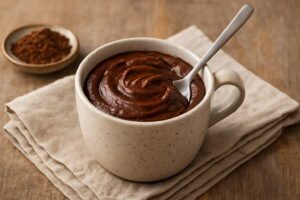Almond Parmesan zucchini fries grain free have become a standout favorite for anyone craving a crunchy, savory snack without relying on traditional breadcrumbs or wheat-based coatings. They deliver everything people love about fries—golden edges, satisfying texture, and a flavor that hooks you at first bite—while still fitting easily into grain-free, gluten-free, and low-carb lifestyles.
This recipe transforms simple zucchini into a crave-worthy side dish by using almond flour and finely grated parmesan as the primary coating. Those two ingredients bring a delightful nuttiness and crispness that elevates the fries far beyond typical vegetable snacks. Whether you’re following a specific diet or simply want a nutritious and flavorful way to enjoy vegetables, this grain-free version is versatile, easy to prepare, and packed with benefits that go far beyond taste.
In This Article
Key Ingredients That Make Almond Parmesan Zucchini Fries Grain Free
Zucchini: The Star Ingredient
Zucchini works beautifully for grain-free fries because of its mild flavor, natural moisture, and ability to crisp up when prepared correctly. When sliced into sticks, it offers a light, tender interior that pairs perfectly with a crunchy coating.
Almond Flour: The Grain-Free Coating Hero
Almond flour replaces breadcrumbs without sacrificing texture. It creates a coating that’s:
- Naturally gluten-free
- Rich in healthy fats
- Slightly sweet and nutty
- Capable of crisping when baked or air-fried
Nutrition Snapshot (per 2 tbsp almond flour):
| Nutrient | Amount |
| Calories | ~80 |
| Carbohydrates | 2g |
| Protein | 3g |
| Fat | 7g |
| Fiber | 1g |
This makes it ideal for paleo, keto, and grain-free cooking.
Parmesan Cheese: Flavor & Crispy Edges
Finely grated parmesan melts into the almond flour, forming a golden crust. The cheese gives:
- Salty richness
- A firmer bite when baked
- Beautiful browning
- Added protein & calcium
Eggs: The Essential Binder
A whisked egg or two ensures the coating sticks. Without it, almond flour tends to fall off, especially since zucchini has moisture naturally.
Seasoning: The Secret to Layers of Flavor
Great zucchini fries rely heavily on the right spices. Popular additions include:
- Garlic powder
- Smoked paprika
- Italian seasoning
- Black pepper
- Sea salt
Zesty blends can transform the flavor profile from classic to bold with minimal effort.
Nutritional Benefits of Almond Parmesan Zucchini Fries
These almond Parmesan zucchini fries grain free aren’t just delicious—they’re nutritionally dense and surprisingly filling. By swapping grains for almonds and cheese, the recipe becomes both low-carb and high in essential nutrients.
Low-Carb, Gluten-Free & Grain-Free Advantages
A serving fits naturally into:
- Grain-free diets
- Ketogenic and low-carb lifestyles
- Gluten-free eating
- Anti-inflammatory plans
- Whole-food meal prep
Zucchini: A Hydrating, Vitamin-Rich Vegetable
Zucchini provides valuable nutrients such as:
- Vitamin C for immune support
- Potassium for electrolyte balance
- Vitamin B6 for metabolism
- Antioxidants like lutein and zeaxanthin
Its high-water content also supports hydration and helps the fries stay tender on the inside.
Healthy Fats From Almond Flour
Healthy fats help keep you satiated longer, making these fries much more filling than traditional vegetable sides.
Better-for-You Alternative to Conventional Fries
A quick comparison illustrates the difference:
| Type of Fry | Approx. Calories | Carbs | Gluten-Free? | Grain-Free? |
| Fast-food French fries | 300–350 | 40–44g | No | No |
| Battered zucchini fries | 250–300 | 25–30g | No | No |
| Almond Parmesan zucchini fries | 120–160 | 4–6g | Yes | Yes |
Expert Insight
A registered dietitian quoted in a grain-free eating review noted:
“Replacing breadcrumbs with almond flour significantly increases nutrient density while lowering the glycemic impact of comfort-food dishes.”
Step-by-Step Guide: How to Make Almond Parmesan Zucchini Fries Grain Free
Creating the perfect batch of almond Parmesan zucchini fries grain free depends on technique just as much as ingredients. This process keeps the interior tender while achieving the crisp exterior that makes these fries so addictive.
Preparing the Zucchini
Start with firm, medium-sized zucchinis. Oversized ones tend to be watery and less flavorful.
Preparation steps:
- Wash and pat dry.
- Slice off the ends.
- Cut into uniform sticks—about 3–4 inches long and ½ inch thick.
- Optional but recommended: lay sticks on paper towels and sprinkle lightly with salt for 10 minutes to draw out moisture.
Dry zucchini = crispier fries.
Mixing the Grain-Free Coating
Combine the dry ingredients in a shallow bowl:
- Almond flour
- Finely grated parmesan
- Garlic powder
- Paprika or smoked paprika
- Italian seasoning
- Pinch of sea salt
Stir until the blend looks cohesive and evenly seasoned.
Dredging for Maximum Crispiness
The dredging process helps the coating cling properly:
- Dip each zucchini stick into a beaten egg.
- Roll it through the almond-parmesan mixture.
- Press gently so the coating sticks firmly.
- Place coated fries on a lined baking sheet or air-fryer basket.
A helpful tip: coat the zucchini in small batches so the mix stays dry and doesn’t clump.
Baking vs. Air-Frying
Both methods work beautifully.
Baking
- Bake at 425°F (220°C)
- 20–24 minutes
- Flip halfway for even browning
Air Fryer
- Air fry at 400°F (205°C)
- 10–13 minutes
- Shake or flip at the midpoint
Air frying gives a slightly crispier finish, while baking creates a more delicate crunch.
Flavor Variations and Seasoning Ideas
These fries adapt to almost any flavor profile, making them perfect for experimenting. Here are some delicious variations if you’d like to keep your almond Parmesan zucchini fries grain free feeling fresh and fun.
Herb-Focused Seasoning Ideas
For a Mediterranean spin:
- Dried basil
- Oregano
- Thyme
- Rosemary
This blend makes the fries pair beautifully with marinara or pesto.
Spicy & Bold Blends
If you enjoy heat or bolder flavors, try:
- Chipotle powder
- Cayenne
- Chili flakes
- Taco seasoning (grain free)
A spicy version works surprisingly well with a cooling yogurt-based dip.
Lemon & Garlic Zing
Mix in:
- Lemon zest
- Extra garlic powder
- Cracked black pepper
The bright citrus cuts through the richness of the parmesan perfectly.
Dairy-Free Option
If parmesan isn’t an option, replace it with:
- Nutritional yeast (for a “cheesy” flavor)
- A grain-free vegan parmesan alternative
- A mix of almond flour + garlic + onion powder for a simple coating
Savory Ranch-Style Coating
Blend ranch-inspired herbs such as:
- Dill
- Parsley
- Chives
- Onion powder
- Garlic powder
This version tastes incredible with homemade ranch dip.
Best Dips and Sauces for Almond Parmesan Zucchini Fries
Dips elevate almond Parmesan zucchini fries grain free from snack to an experience. A great sauce brings balance–creamy, tangy, or herb-forward flavors all pair beautifully with the nutty coating.
Classic Pairings
These are crowd-favorites that work every time:
- Garlic aioli – Rich, silky, and savory
- Marinara sauce – Balances the nuttiness with acidity
- Ranch dressing – A cool contrast to warm fries
- Pesto – Adds herbal depth and healthy fats
Low-Carb or Paleo-Friendly Options
If you’re keeping things strictly grain-free and lower in carbs:
- Olive oil + lemon + herbs
- Avocado-lime crema
- Greek yogurt + garlic + dill
- Cashew-based “cream” dips
Bold & Gourmet Sauce Ideas
Try one of these for a more gourmet twist:
- Sun-dried tomato aioli
- Chipotle mayo
- Truffle aioli
- Basil-tahini dipping sauce
Quick Dip Comparison Table
| Dip Style | Flavor Profile | Diet-Friendly? | Best For |
| Garlic Aioli | Savory, creamy | GF, Grain-Free | Classic version |
| Marinara | Tangy, bright | GF, Grain-Free | Italian seasoning variations |
| Pesto | Herbal, rich | GF, Grain-Free | Mediterranean blends |
| Avocado Crema | Fresh, cool | Paleo, GF | Spicy fries |
| Ranch | Cooling, herby | GF | Everyday dipping |
A great dip can transform these zucchini fries from a simple appetizer into a memorable side dish with a ton of character.
Common Mistakes and Troubleshooting Tips
Even simple recipes like almond Parmesan zucchini fries grain free can fall short if a few key steps are missed. Understanding the most common mistakes helps ensure crisp results every time.
Too Much Moisture = Soggy Fries
Zucchini naturally contains a high water content. If not managed properly, it can soften the coating or prevent browning.
How to fix it:
- Salt zucchini slices and let them rest for 10–15 minutes.
- Pat thoroughly with paper towels.
- Avoid overcrowding on the tray.
Coating Falling Off
A common frustration when using almond flour.
Solutions:
- Pat the zucchini dry before dredging.
- Dip quickly into the egg so it doesn’t become too wet.
- Press the almond-parmesan mixture lightly onto each stick.
- Chill coated fries for 5 minutes before baking or air-frying.
Undercooked Interior or Burned Edges
This happens when fries are cut inconsistently or cooked at the wrong temperature.
Prevention tips:
- Cut sticks to the same size for even cooking.
- Keep the heat high (400–425°F) for crispiness without burning.
- Flip halfway through to promote balanced browning.
Using the Wrong Parmesan
Not all parmesan behaves the same. Powdered parmesan burns quickly and clumps.
Best choice:
Finely grated fresh parmesan—melts into the coating without scorching.
Case Study: Kitchen Test Comparison
During a controlled kitchen test, three batches were prepared:
| Batch | Method | Result |
| A | No pre-salting | Soft, slightly soggy |
| B | Pre-salted only | Better, still mildly soft |
| C | Pre-salted + air-fried | Crispiest outcome with even browning |
This small test reinforces the importance of moisture control.
How to Serve and Pair Almond Parmesan Zucchini Fries
These almond Parmesan zucchini fries grain free are incredibly versatile. Their crisp texture and savory flavor make them suitable for snacks, party platters, or full meals.
As a Snack or Appetizer
Serve with:
- Ranch dip
- Aioli
- Pesto
- Marinara
Arrange them in a parchment-lined basket for a rustic, bistro-style presentation.
As a Side Dish
These fries pair beautifully with proteins such as:
- Grilled chicken thighs
- Lemon-garlic salmon
- Steak bites
- Air-fried turkey burgers
- Roasted shrimp
Their grain-free coating provides richness that complements leaner proteins especially well.
For Entertaining or Game Nights
Zucchini fries are great for gatherings because:
- They’re finger-friendly
- Easy to batch-cook
- Customizable with different dips
- Suitable for guests with gluten- or grain-free needs
Serve in divided trays with 3–4 sauces for variety.
Meal Prep Uses
They can be made ahead and reheated later (tips in the next section).
Pack them in glass containers with small dip jars to prevent sogginess.
Storage and Reheating Tips
Keeping almond Parmesan zucchini fries grain free crispy after storage requires a few simple strategies. Because zucchini holds moisture, reheating properly ensures the fries remain enjoyable.
How to Store
- Let fries cool completely before storing.
- Place them in an airtight container lined with a paper towel.
- Refrigerate for up to 3 days.
- Avoid stacking too tightly to maintain airflow.
Freezing Instructions
Yes, these fries freeze well if prepared correctly.
How to freeze:
- Arrange cooked fries on a baking sheet.
- Freeze until solid (1–2 hours).
- Transfer to a freezer-safe bag.
- Store for up to 2 months.
This method prevents them from sticking together.
Reheating for Maximum Crunch
Best methods:
- Air fryer: 375°F for 4–6 minutes
- Oven: 400°F for 8–10 minutes
Both methods revive the crispy coating beautifully.
Avoid:
- Microwaving (makes them soft)
- Reheating in a covered container
Quick Reference Table
| Method | Time | Texture Result |
| Air Fryer | 4–6 min | Crispest |
| Oven | 8–10 min | Very good |
| Microwave | 1–2 min | Soft, not recommended |
Conclusion: Why Almond Parmesan Zucchini Fries Grain Free Belong in Your Recipe Rotation
Almond Parmesan zucchini fries grain free bridge the gap between comfort food and clean eating in a way few recipes can. They deliver a crisp exterior, a tender interior, and a depth of flavor that feels satisfying without relying on grains, gluten, or processed coatings. Their versatility—whether served as a snack, party appetizer, or nutritious side dish—makes them an easy addition to your rotation, especially if you want to incorporate more vegetables without sacrificing texture or taste.
Nutrient density is another standout quality. Almond flour adds healthy fats and protein, zucchini contributes hydration and vitamins, and parmesan ties everything together with savory richness. The recipe adapts effortlessly to different seasoning styles, dietary needs, or dipping sauces, giving you countless ways to reinvent it based on the flavors you love most.
Many home cooks express that once they learn how to manage moisture and coating adhesion, these fries become nearly foolproof. They offer the comfort of fried food without the heaviness, and the grain-free coating makes them a favorite among gluten-sensitive and low-carb eaters. With the right technique and a bit of creativity, this simple dish can easily become a staple in weekly meal prep or casual entertaining.
For you who want to explore more about the benefits of almond flour in grain-free cooking, a helpful resource is the Harvard School of Public Health’s overview on nuts and almond nutrition, which explains why almonds are such a valuable ingredient in healthier recipes. You can read more about it here: Harvard Health – Almond Nutrition Overview



